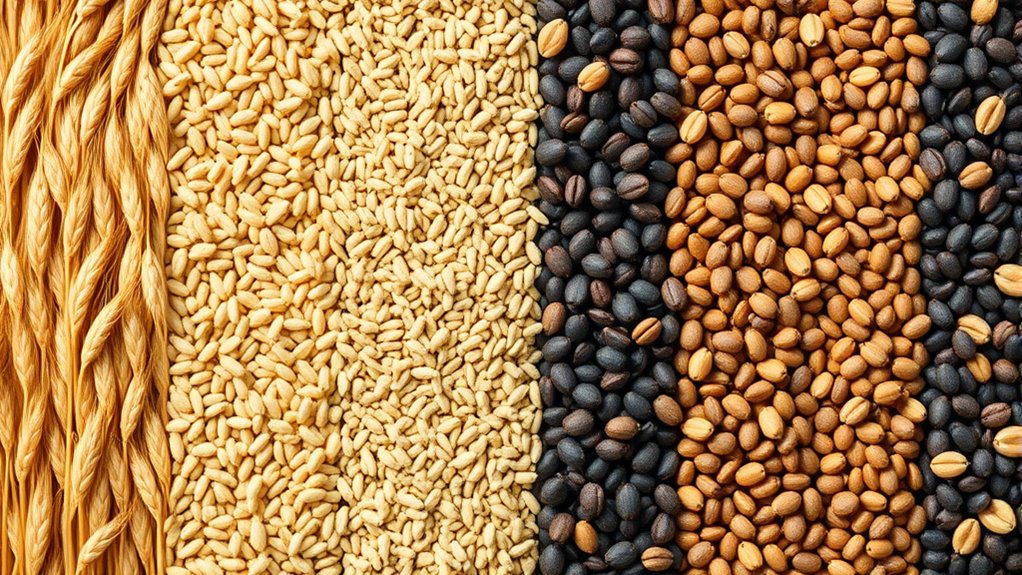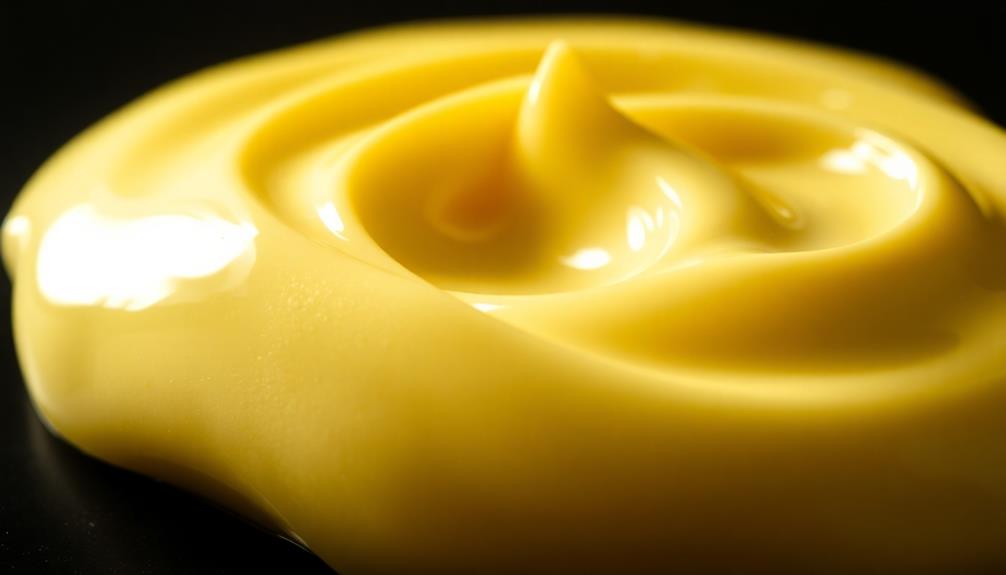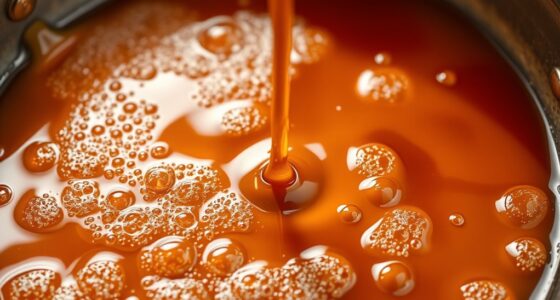Global wheat varieties vary widely in protein levels, impacting baking and nutrition. Hard wheat from North America and Australia often contains 12% or more protein, ideal for bread with strong gluten. Soft wheat, common in Europe, has 8-10% protein, perfect for pastries and cakes. Environmental factors and farming practices also influence these levels. To discover how these differences affect your baking, explore more about wheat varieties and their properties.
Key Takeaways
- Wheat protein levels vary globally, with hard wheat (North America, Australia) typically containing ≥12%, ideal for bread-making.
- Soft wheat (e.g., in Europe, Asia) has lower protein (8-10%), suitable for pastries and cakes.
- Environmental factors like climate and soil influence wheat’s protein content across different regions.
- Cultivation practices and harvest timing also affect the gluten quality and overall protein levels.
- Nutritional profiles differ alongside protein content, with ancient grains often offering richer nutrients.

Understanding wheat protein levels is essential whether you’re a baker, nutritionist, or farmer. The gluten content in wheat markedly influences how flour behaves in baking, affecting everything from dough elasticity to final product texture. But beyond baking qualities, wheat protein levels also determine the nutritional variations across different wheat varieties. Recognizing these differences helps you select the right type of wheat for your specific needs, whether you’re aiming for a light loaf or a health-conscious snack.
Wheat protein levels influence baking quality and nutritional value, guiding your choice for optimal results.
Wheat with higher protein content generally has a higher gluten content, which provides the structure needed for bread that rises well and maintains its shape. Hard wheat varieties, commonly grown in regions like North America and Australia, often contain 12% or more protein. These are ideal for bread-making because their gluten network gives strength and elasticity. Conversely, soft wheat tends to have lower protein levels, usually around 8-10%, making it suitable for pastries and cakes where tenderness is desired. The gluten content directly impacts the dough’s stretchiness and ability to trap air, influencing the final texture of baked goods. Additionally, environmental factors such as climate and soil quality significantly influence wheat protein levels, with optimal conditions leading to higher gluten content.
From a nutritional standpoint, higher protein wheat also offers increased amino acids, making it a better source of essential nutrients. However, this isn’t the only factor to take into account. Different wheat varieties present nutritional variations beyond protein content, including fiber, vitamins, and minerals. For instance, ancient grains like spelt or emmer often boast richer nutrient profiles compared to modern wheat, even if their protein levels are comparable. This means that when choosing wheat, you should take into account both gluten content and overall nutritional value to meet your dietary or culinary goals.
Farmers and growers can influence wheat protein levels through cultivation practices, such as the timing of harvest and environmental conditions. Warmer climates and nitrogen-rich soils tend to yield wheat with higher protein content. Meanwhile, plant breeders are continually developing new varieties that balance gluten content with disease resistance and yield, providing more options for different markets and uses. Additionally, understanding how agronomic practices impact wheat quality can help optimize both yield and nutritional content for growers. Furthermore, selecting appropriate wheat varieties based on regional growing conditions can enhance both yield and quality, aligning with specific market demands. Recognizing the role of environmental factors in wheat development enables better prediction and control of wheat quality outcomes.
As a baker or nutritionist, understanding these variations helps you tailor your ingredients to achieve specific results. Higher gluten content means stronger doughs and chewier textures, but it also means paying attention to nutritional details if you’re catering to health-conscious consumers. By recognizing the relationship between wheat’s gluten content and nutritional variations, you gain a more precise control over your baking and dietary choices. This knowledge allows you to select the appropriate wheat varieties to optimize both the function and health benefits of your baked goods.
Frequently Asked Questions
How Do Climate Changes Affect Wheat Protein Content Globally?
Climate impact influences wheat protein content worldwide, and you’ll notice that higher temperatures and changing rainfall patterns lead to protein adaptation in crops. As the climate shifts, wheat plants often produce less protein, affecting baking quality and nutritional value. You can observe these effects in different regions, where farmers adapt their practices to maintain protein levels. Understanding this helps you appreciate the importance of resilient wheat varieties amid climate change.
Which Wheat Varieties Are Best for High-Protein Baking?
If you’re aiming for high-protein baking, choose wheat varieties known for strong gluten strength, like hard red spring wheat or durum wheat. These types offer superior baking quality, giving your baked goods better structure and chewiness. Look for labels indicating high protein content or specific wheat types suited for bread making. By selecting these varieties, you’ll guarantee your baked products have the desired texture and resilience.
Are There Health Benefits Linked to Higher Wheat Protein Levels?
When it comes to health benefits of higher wheat protein levels, you’re often chasing a double-edged sword. Increased protein can boost nutritional value, but it might also worsen gluten sensitivity and affect digestibility effects. If you’re sensitive or have digestive issues, higher protein wheat might do more harm than good. Always weigh the benefits against potential health risks, and consult with a healthcare professional if you have concerns.
How Do Farming Practices Influence Wheat Protein Variability?
You can influence wheat protein variability through your farming practices by managing soil nutrients and irrigation techniques. When you optimize soil nutrients, you provide the essential minerals that support protein development. Proper irrigation ensures the wheat receives consistent water, which helps maintain protein levels. By adjusting these practices, you can increase or stabilize protein content, ultimately impacting the wheat’s quality and nutritional value.
Can Wheat Protein Levels Be Naturally Enhanced Through Breeding?
You can naturally enhance wheat protein levels through selective breeding, which involves choosing plants with desirable traits. While genetic modification offers precise improvements, organic cultivation focuses on natural methods without genetic interference. Breeding can increase protein content by selecting high-protein varieties, but it’s a gradual process. Both approaches aim to improve wheat quality, with organic methods emphasizing sustainability and natural growth, while genetic modification can accelerate protein enhancement.
Conclusion
So, as you navigate today’s flour aisle, remember that not all wheat is created equal—some packs pack a punch with higher protein levels, much like a knight of old wielding a mighty sword. Your choice impacts your baking and nutrition, so don’t just settle for the first bag you see. By understanding these global differences, you’re better equipped to pick the perfect wheat for your culinary quests—no need to be a caveman when it comes to flour!










